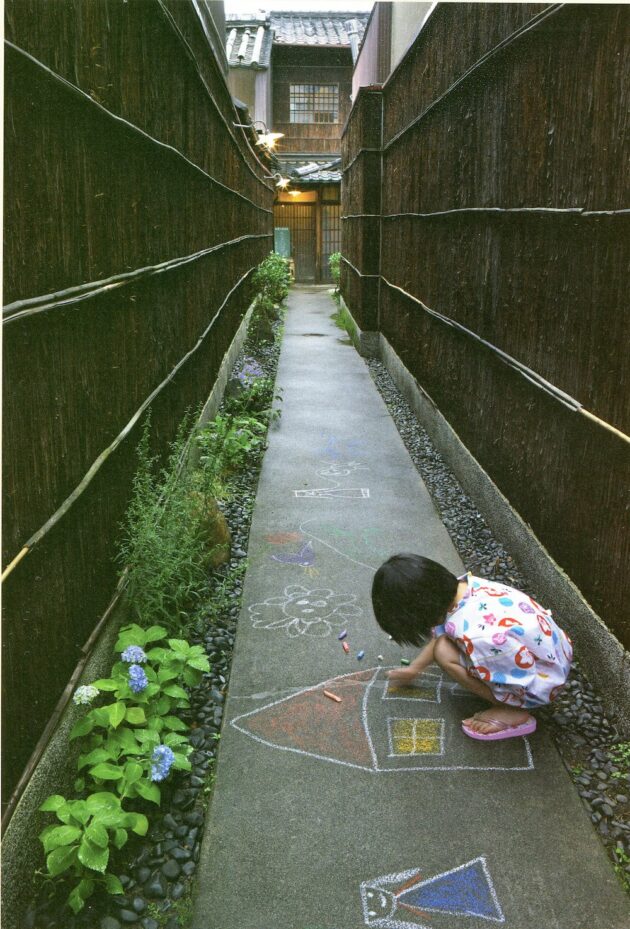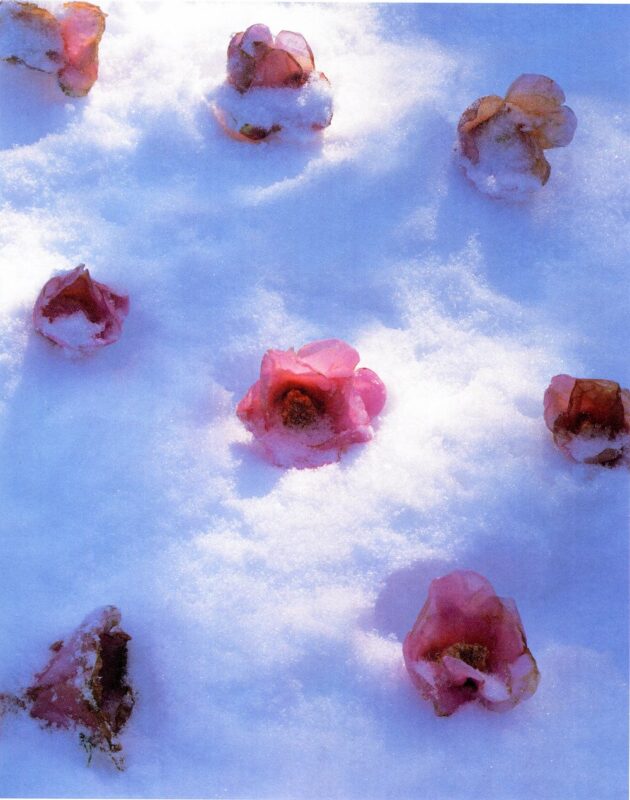
100 Views of Kyoto (KJ100): Kyoto View 85 – An interview by John Einarsen, excerpted from KJ70 (Kyoto Lives, 2008)

Millions have experienced Kyoto through the eyes of photographer Mizuno Katsuhiko. His grand vision is of an idealized Kyoto, one without the modern clutter — natural landscapes, the seasons, gardens, and temples in their purest, most beautiful state. With some 140 published books over four decades, countless calendars and exhibitions, Mizuno has arguably been one of the most influential individuals in defining Kyoto’s natural beauty and stimulating Kyoto people’s pride in their city.
As a child, Mizuno’s daughter Kayu accompanied him on many of his photo outings. Now grown and a mother herself, she has become a fine photographer in her own right, portraying Kyoto neighborhoods and writing about machiya (traditional townhouse) culture for a local magazine. In 2005 she published Kyoto Alleyway Scenes (Kyo no roji fukei, Toho Shuppan). Seated side by side on a sofa in their machiya photo gallery, the Mizunos talked about photography and Kyoto.
Katsuhiko, were you among the first photographers to start taking color photographs of Kyoto scenery?
Katsuhiko: Yes. When I began it was the era of monochrome. Then I thought I would try color and fumbled around with color film until I could express images with it. I had studied journalism in Tokyo and my teacher was the son of [garden designer] Shigemori Mirei,* and I often spent time at his house. Later I moved to Kyoto and wanted to pursue photojournalism. I had to eat, so I began taking photographs of Kyoto’s scenery. It was around the time when a professional could start making a living by taking landscape photos. I hadn’t studied art photography. I learned most everything on my own, from photo to photo. However, I learned how to think about photography from Shigemori. That was more than 30 years ago. It was when Japanese people started to take trips abroad. So they could relate to color photographs that expressed the beauty of a place.
Kayu, when did you first become interested in photography?
Kayu: Probably, the first was…
Katsuhiko: …her playtime was breaking apart my old cameras…
Kayu: …in elementary school. I won a prize in the Yomiuri Shimbun photo contest with a picture of a crocodile I took in the zoo. Then in high school, I was always assisting my father. In college I started taking photos for myself.
Katsuhiko, what kind of eye does Kayu have?
Katsuhiko: She doesn’t carry around a camera all of the time, but when a camera is in her hands, I am surprised at how well she can make a great “slice” from daily life. She doesn’t take photos so often, as a child and even now. Take the scene we all see here now, well, she has the skill or talent to frame an excellent image from this. So she takes photos that surprise people and move me. I suppose she learned this naturally by growing up around a photographer. She did not go to photo school and I didn’t really teach her. There is a Japanese proverb, “Monzen no kozou narawanu kyou wo yomu” (“Kids remember scriptures by just hanging around the temple gate”). It means you learn things naturally from what you see or listen to all the time. Occasionally Kayu won prizes. And she won them easily. But I did not take them so seriously. She learned naturally. This is her talent. She studied geography and Japanese history in school. If she had studied only photography, her vision would be narrower. With her background she has a wider view of her subject matter. I also like how seriously she delves into her photographic subject matter.
Kayu, which era of Kyoto history most interests you?
Kayu: Well, I majored in geography, so what I really love is maps and the machinami (rows of machiya). So I am familiar with what buildings were here from the Heian period, and on top of Heian-kyo new buildings were built. Kyoto sits on layers of history. I feel like a time traveler, walking around the roji (narrow lanes) — especially when I find an old monument…
Did growing up in Kyoto influence your photographs?
Kayu: I was influenced by daily Kyoto life. Kyoto is a craft town. There are many different kinds of craftspeople and my grandparents were among them; their house was in Nishijin. The small and refined seasonal festivities and traditions that were handed down in this old section of town blended into my daily life. These days Kyoto has been changing greatly so that we have lost a lot of our traditional lifestyle. To have been able to experience this rich world growing up, the traditional food, clothing and shelter, was very valuable for me. That is why for my photographic subjects I am interested in the things we have left of that traditional life and history. I pass on these things to my child and the next generation through photography and writing. Also, the little forest in the shrine, streams, alleys, vacant lots were all where I used to play, so when I point my camera towards this scenery I recollect my childhood with great warmth.

How else has Kyoto changed?
Kayu: The number of machiya has decreased. And I still can remember the old streetcars running…
Katsuhiko: The first photo book I published was on tsubo niwa (courtyard gardens) in Kyoto. About half of the fifty or so gardens I shot for that book no longer exist. The courtyard gardens in temples are safe, but those that were part of machiya have disappeared. So I am keeping one machiya here, and if people look after them one by one, then they can be preserved. Even though there are signs of a machiya revival today, they are still disappearing. One reason is that houses are passed down to all of the children these days instead of just to the older son. Since the siblings cannot all live there, they end up selling the house. And of course the inheritance tax is very high. Also, repairing machiya is quite expensive; full renovation can cost issenman or nisenman (US$100,000-200,000).
Where is your favorite place in Kyoto?
Katsuhiko: My favorite place is this house, this environment. You feel this way when you get older… Speaking in the abstract, I favor places where there is harmony between human-made things — like the place we live now, machiya, of course temples — and nature. Where they are mixed in harmony — that is Kyoto. The charm of Kyoto is where nature fuses well with the human-made. Although Nara is older than Kyoto, it no longer has the continuation of culture that Kyoto has. That is why I cannot leave Kyoto and why I never tire of taking photos here.
As a Kyoto photographer you must be especially attuned to the subtle changes of the seasons?
Katsuhiko: Now there is snow… In early spring, for example you have snow with sazanka (Camellia sasanqua) or nanten (nandin), which are beginning to bloom. So at this time of year you have red flowers or berries with the beauty of white snow. The plums are just beginning to bloom. In a week they will be out. Next will be peach, and then cherry blossoms. I take photographs every day, so I don’t expect to see dramatic changes. Things change a little at a time. This year we had a cold spring, so I am looking forward to the possibility of cherry blossoms in the snow.
Kyoto falls right in the middle of the climatic influences of the Pacific Ocean, omote nippon or the front side of Japan, and those of ura nippon the back side of Japan, the Sea of Japan and its continental weather. Kyoto is where these climates intermix. There is a word, shigure (light shower), which probably originated in Kyoto. It describes a light temporary rain. Kyoto can experience the climates from both sides of Japan in a single day. There can be rain, sunshine, rainbows, coldness and warmth all in a day. I especially love taking photographs of flowers from spring to summer. They are changing almost every week, so it is a lot of fun. When it snows, sometimes I lie awake at night excited, anticipating what it might be like outside and where I might go early in the morning.

* Shigemori Mirei (1896 – 1975) was a famous contemporary garden designer, most noted for his design of the gardens at Kyoto’s Tofukuji Temple.

John Einarsen is KJ’s founding editor and now, publisher. An active photographer, he is the author of Kyoto: The Forest Within the Gate (with poems by Edith Shiffert), Small Buildings of Kyoto Vol I & II, Zen Gardens and Temples of Kyoto (with John Dougall) and the forthcoming This Very Moment: The Experience of Seeing.
Photos by Mizuno Katsuhiko, Mizuno Kayu, and John Einarsen